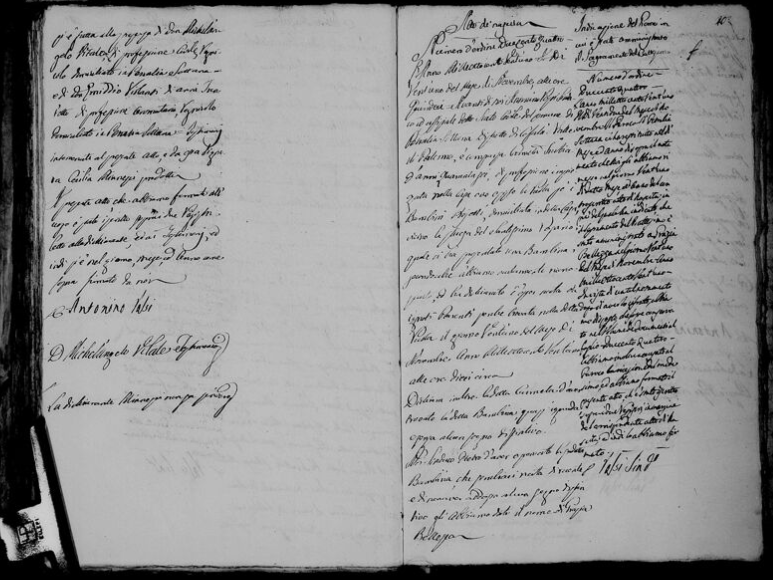Ruota dei Proietti (Foundling Wheel or Wheel of Castoffs)
I first became interested in abandoned newborns in 19th century Sicily when I found that one of my extended family in Petralia Sottana was an abandoned newborn. He was given a first name and surname, but the surname was very different than any of the family names of those who resided in Petralia Sottana.
(There were perhaps 100-150 particular families in Petralia Sottana from 1820 though 1900, many of which you can see in the map of the town here and here).
Below in the Resources section you can find a number of great articles about the “foundling wheel” employed by churches throughout Italy, including photos.
Parents Unknown
In the Petralia Sottana civil records (birth, death, marriage), you may have seen the term “parenti ignoti” or “genitori incerti” – meaning that the parents of a newborn left at a church or elsewhere in the town are unknown.

Source: 1826 Deaths, image 126 of 135:
https://antenati.cultura.gov.it/ark:/12657/an_ua927049/LexreJo
The birth and records may have additional details.

Source: 1826 Death index, image 72 of 135:
https://antenati.cultura.gov.it/ark:/12657/an_ua927049/Lz8kWJg
The above death record states that the child died at the age of 4 years, 8 months, and was in the care of “nutrice” (wet nurse) Gandolfa Ilarda. The woman who minded the ruota del bambini proietti (the wheel of castoff children) was Carmela Trubia. Carmela reported both the child’s birth and death (see below).

Source: 1821 births, image 217 of 252:
https://antenati.cultura.gov.it/ark:/12657/an_ua927347/58J9Wk8
Very occasionally, the parents would later claim their abandoned child. Usually the details were in a post-dated birth record, and usually in the Diversi records. One record I saw stated that the parents were unmarried when the child was born, and after marrying they officially claimed the child.
Unique Surnames
Understanding the foundling surname process for the particular town you are researching can help you figure out if you should be researching an actual family, or if you are looking at a foundling surname. It may be a matter of recognizing the surname naming pattern in the records.
As an aside, in my experience, looking through birth, death and marriage index pages and records over many years allows you to begin to recognize the Petralia Sottana surnames, versus those from distant towns or those who have foundling surnames. In the Petralia Sottana death records, the town the person was from is listed in the Patria (birth place) column.
In the case of my extended family member, once I realized he was a foundling, I did not spend any more time looking for prior records with that surname, since it was “made up” for him.
Some of the articles below describe the stigmatization of abandoned children by either the specific surname they were given, such as Esposito (exposed) or that they were given no surname at all. However, as mentioned above, in Petralia Sottana the children were given unique surnames that did not match any Petralia Sottana family names. This would seem a good solution so that no abandoned child would be mis-recognized as belonging to a “respectable family,” but it could also be a form of stigmatization. At least the surnames were unique, as you can see here.

Examples of foundling surnames. 1851 Diversi, listing proietti birth surnames. Image 24 of 25:
https://antenati.cultura.gov.it/ark:/12657/an_ua926717/0nGZMzr
In the above record, you can see a rare note in the Observations section indicating that Giuseppa Destro was recognized as the daughter of Donna Domenica Ventimiglia (residing in Palermo and the oldest child of the late Don Giovanni Ventimiglia), and Barone Don Antonio Destro (details in records #13 and #16 of that image roll).
Here is the record 13 image for that child:
https://antenati.cultura.gov.it/ark:/12657/an_ua926717/wr7Zlz8
Here is an 1852 record noting that the parents acknowledge their child (born in 1851 and given a foundling surname).
https://antenati.cultura.gov.it/ark:/12657/an_ua926723/0MxdOmD
I am not a native Italian speaker or reader so I could be wrong, but this 1860 record appears to be the true father acknowledging the parentage of four foundling children.
https://antenati.cultura.gov.it/ark:/12657/an_ua926754/wbBKeZv
(If you can translate this entire record, please post a comment below, or send me an email and I will add it to this post, crediting you.)
Foundling Articles
http://www.conigliofamily.com/Foundlings.htm
http://www.conigliofamily.com/OrphansIllegitimatesFoundlings.htm – also great examples of birth record translations
https://www.lagazzettaitaliana.com/history-culture/9713-la-ruota-the-wheel
http://www.grandvoyageitaly.com/history/the-adoption-wheel-la-ruota-del-trovatello
https://www.familysearch.org/en/wiki/Italy_Orphans_and_Orphanages
One response to “Abandoned Newborns and The Wheel”
Wonderful research Janna – thanks for sharing. Any idea how common the practice of leaving a new born for foundling was at this time? My Sicilian is not good, but looking quickly at some of the Atti Diversi in Petralia Sottana in the 1850’s and comparing the numbers to the other recorded births, it looks like 10-20%. (1854 – 40 “genetori incerti” in the Diversi vs 253 Nati records.)